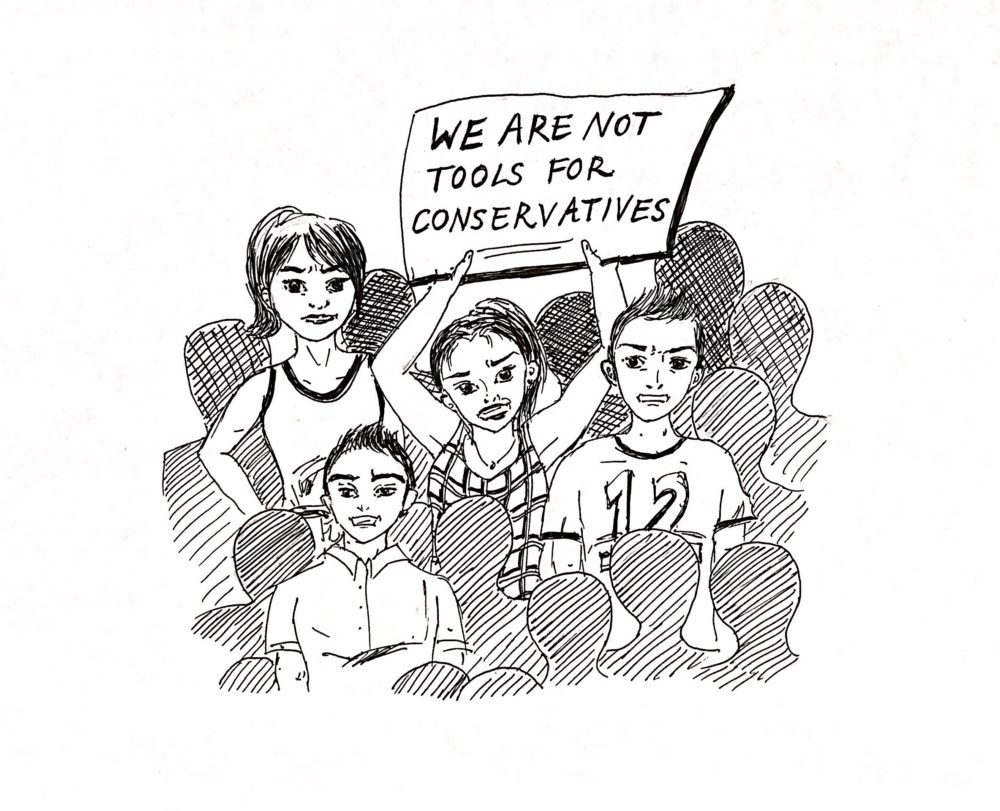Injustices have punctuated the history of Asian Americans in the United States — from the banning of Chinese immigrants to the internment of Japanese Americans throughout the West Coast. Despite this, Asian Americans today as a group are the highest earners in the United States, with a median household income of $81,431 in 2016, according to the United States Census Bureau. They are also among the most educated, with more than 50 percent holding a bachelor’s degree or higher. These outcomes have resulted in a “model minority” trope; that is to say that Asian Americans’ success is often explained in terms of their ability to “work harder” than other minority groups, or them having “more stable families” than African Americans and Latinos. Unfortunately, this kind of rhetoric often ignores the specific struggles of different minorities, both inside and outside the Asian-American community, and incorrectly characterizes Asian Americans as the gold standard for minorities in the United States.
The broader consequences of characterizing Asian Americans as a model minority are apparent in our country’s political sphere. Just a year after the Supreme Court’s ruling to uphold race-conscious college admissions in 2016, an advocacy organization, Students for Fair Admissions, brought forward a lawsuit accusing Harvard University of systematically discriminating against Asian-American applicants. The trial is set for this October, and the group claims it seeks to “restore the original principles of our nation’s civil rights movement.” The Students for Fair Admissions boasts a membership of over 20,000 students and parents, and is consistent with the noticeable rise in student activism over the past few years. With that said, I don’t embrace a cause which, if successful, would inflict widespread damage on minority communities, Asian Americans included. A victory for the plaintiffs would likely see an end to affirmative action, a federal policy that helps ensure students of underrepresented racial backgrounds receive more equitable access to higher education.
This lawsuit isn’t born out of concern for Asian-American students. To understand the movement, one need only begin with the organizer. The group’s leader, Edward Blum, has a long history of opposing affirmative action, and has made headlines in recent years for taking high-profile lawsuits to the Supreme Court, most notably Fisher v. University of Texas, where he argued against race-conscious admissions for a white student. It is also no surprise that the Trump administration has chosen to publicly support the Students for Fair Admissions, given its recent decision to do away with Obama-era policies encouraging race-conscious admissions designed to help increase the college‘s chances of underrepresented minorities. Champion of minorities that he is, Blum lauded the Trump administration’s decision.
For these conservative groups and figures, the end goal is not to protect Asian Americans, or any minority group for that matter. It’s to dismantle policies that, for decades, have emphasized the importance of diversity and ensured a higher number of students from marginalized communities have a fairer chance to attend college. Despite the commonly circulated argument that Asian-American students stand to benefit greatly from removing affirmative action, a 2016 study found that if Latino and African-American applicants were to be removed from the Harvard admissions pool, the admissions chances of Asian-American students would rise by a meager one percent. The authors of the study later attribute this statistic to a “white admissions advantage.” They explain that it’s due primarily to underrepresented minorities already making up such a small fraction of the applicant pool; thus, gutting affirmative action would disproportionately benefit white students, not Asian Americans.
As a matter of fact, the Asian-American community still relies heavily on affirmative action policies. Even with the conservative media driving a narrative that victimizes Asian Americans to affect public opinion on affirmative action policies, a 2016 poll by Asian Americans Advancing Justice found that 64 percent of Asian Americans favor affirmative action policies intended to help women and minorities increase access to higher education. Southeast Asians remain amongst the poorest and most underrepresented communities educationally, with only 27 percent of Vietnamese Americans and 17 percent of Hmong and Cambodian Americans holding an undergraduate degree. This is the defect in lumping 20 million Asian Americans into one homogeneous group and branding it successful: it allows opponents of affirmative action to co-opt the Asian-American community and use it to make their case against policies that uplift other communities, all under the guise of solidarity.
Have no doubt, ending affirmative action would have consequences near and far. Colleges like Occidental — whose strength is drawn from a commitment to diversity — are particularly vulnerable, with 41 percent of the student body coming from communities of color.
Ultimately, the responsibility falls on students, as primary stakeholders, to safeguard campus diversity. The growth of recent student movements didn’t fall from the sky; it’s the product of students realizing the impact of their collective voice. Moving forward, we all need to focus on protecting the diversity that enriches our education and prevents our communities from being undermined by opportunists masquerading as our advocates.
![]()



































